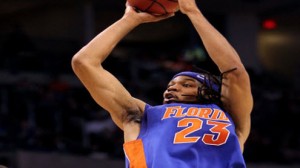
They lost in round one to Brigham Young 99-92 in double overtime. For the Gators last season was about improvement, and this season should be about dominance as Florida battles Kentucky for the top spot in the East Division. A lot is expected of these Billy Donovan coached Gators. Will they disappoint?
Florida returns each of its five starters. Perhaps the most important player to return is senior power forward Alex Tyus (6-8, 220 lbs., SR, #23, 11.8 ppg, 6.9 rpg, 0.4 apg, 28.4 mpg, .503 FG, .400 3PT, .683 FT) who had declared for the NBA Draft and then decided to come back. That is certainly a major development for the Gators, as Tyus, a potential All-SEC player, gives the frontcourt amazing versatility. The power forward is a topnotch rebounder on defense, offers a fine inside shot and can knock them in from downtown. On a team with very few three-point shooters, he is their most accurate guy from beyond the arc.
Another forward, Chandler Parsons (6-9, 218 lbs., SR, #25, 12.4 ppg, 6.9 rpg, 2.6 apg, 31.0 mpg, .493 FG, .358 3PT, .662 FT) is back after putting in a breakthrough season last year. He’s an effective rebounder with a smooth shot and is an able passer. As last season progressed, he hit numerous clutch shots and became an effective playmaker and assist man. He had the highest success rate of those who consistently shot from the three-point arc and Parsons became an important stabilizing force on the court.
Another senior, center Vernon Macklin (6-10, 240 lbs., SR, #32, 10.6 ppg, 5.5 rpg, 0.8 apg, 25.3 mpg, .607 FG, .000 3PT, .588 FT) comes back to round out the front. Macklin was tops on the team in offensive rebounding, grabbing 11.8%, ranking him 151st in the nation. In terms of field goal efficiency, he was one of the best at 60.7, which put him 31stin the country. What may have been most impressive last year was how much the center improved from the start of the season to the end.
If you haven’t already check out the college basketball sports picks page. You can get some info and hop board for both free and premium picks that actually win against the college basketball point spread!
The backcourt will be occupied by two returning players: Kenny Boynton (6-2, 183 lbs., SO, #1, 14.0 ppg, 2.6 rpg, 2.7 apg, 32.9 mpg, .376 FG, .294 3PT, .747 FT) and Erving Walker (5-8, 171 lbs., JR, #11, 12.6 ppg, 3.3 rpg, 4.9 apg, 32.9 mpg, .339 FG, .347 3PT, .812 FT). Point man Walker is an undersized but driven player who led the SEC in assists, while shooting guard Boynton is back as the team’s leading scorer. But both struggled at times last season, as they were inconsistent and unpredictable shooters. Walker can be challenged and beat on “D” due to his size. Boynton has the ability to slash to the basket and can use that talent to put points on the board. Both were solid from the foul line.
One problem for the backcourt duo was the fact that both played so many minutes. There is relief on the way in the form of hot shooting point guard Scottie Wilbekin. The 6-2 Wilbekin, a freshman, will certainly see time at the point and may even start at times. He gives this team needed depth in the backcourt.
Also expect to see freshman swingman Patric Young playing inside. The 6-9. 225-pound Young brings his up tempo, highly energetic game to the court. Young was a McDonald’s All-American and a talented scorer. Last season, Erik Murphy (6-9, 217 lbs., SO, #33, 3.5 ppg, 2.4 rpg, 0.2 apg, 9.1 mpg, .600 FG, .000 3PT, .588 FT) put in quality minutes as a freshman. He can score and rebound inside.
In talking through the team’s 2009-2010 numbers, it’s important to realize that with a more experienced and deeper squad they should improve. In some ways, such as accuracy in the backcourt, they must for this team to get to a new level. On offense, the Gators came in at 112.6, which was 32nd in the country. A major positive for Florida was in the category of offensive rebounding. The team percentage was .370, putting them 35th in the country. Although they hit 70.3 of their frees only 19.2% of their points came from the charity stripe. In the conference, they placed 11th in three-point percentage and eighth in two-pointers. Both of those stats must also improve.
The club was lacking on defense. Although their defensive efficiency came in at 94.9 (67th), this was a team that could not block shots. They were 256th in block percentage. The Gators had just 40 blocks all year, putting them last in the conference. They were better on steals, earning a 97th ranking with a steal percentage of 10.6%.
When it came to shot percentage, opponents connected on 68.0% (119th) of their twos and 32.5 (85th) of their threes. That meant opponents hit just 2.3% less of their twos than the Gators and they were good 1.2% more often on their threes. Opponents shot more threes than the Gators and the same number of twos. All of that meant that a bunch of games were closer than the Gators wanted them to be. This team played a slew of contests where the margin was between 1 and 5 points.
Head coach Billy Donovan (366-159 in 16 years, 333-139 in 14 years at Florida) finally has a full squad after three seasons of thin rosters and defections. With decent depth and experience on-hand, Donovan should be able to get his team to pressure teams more. He expects his players to be better rested and able to be more aggressive. He’d also like to see the club be more successful from downtown as the Gators hit just 31.3% of their threes, ranking them 12th in the SEC. Expect to see some old-time Gator basketball as Florida presses on defense and runs on offense for the first time since 2007.
There are high expectations for the Florida Gators. But what does that mean? It means that coach Donovan and company should be very competitive in the SEC. With only one major loss, forward Dan Werner (4.6 PPG, 4.1 RPG, 1.3 BPG), and experience galore in the form of returning seniors, juniors and sophomores, the Gators are poised for a breakout year.
The freshman class is solid and at least two of the five new guys will see important minutes. Of the returning players, Parsons is perhaps the biggest force due to the fact that he is so versatile. He can change the complexion of a game quickly.
On the national front, this is a top 10 team that can be competitive in the NCAA Tournament. Don’t expect them to get to the Finals but a Sweet 16 appearance seems in order. And next year, if the new guys work out and Donovan can bring in some top prospects, Florida will be in the mix again for top spot. After a two-year drought, the Gators are back on target and ready to play and compete versus the best. As the 2010-2011 season starts, Florida is ranked seventh in the nation.














